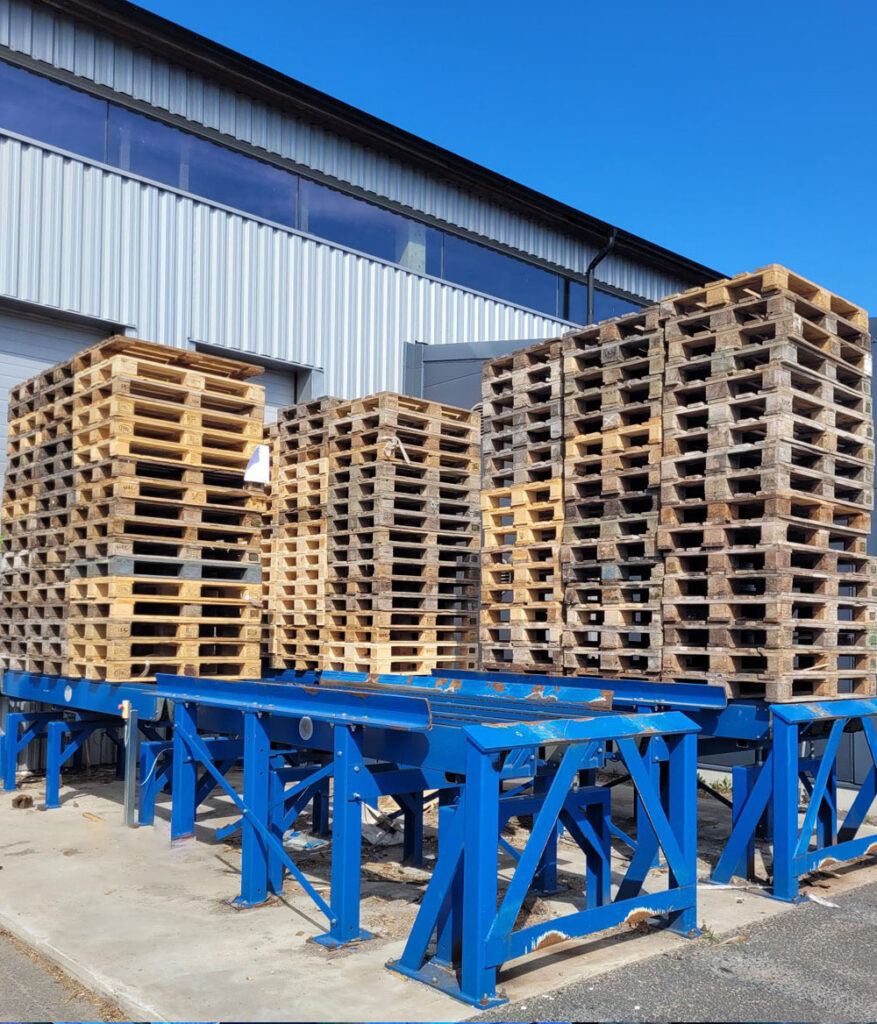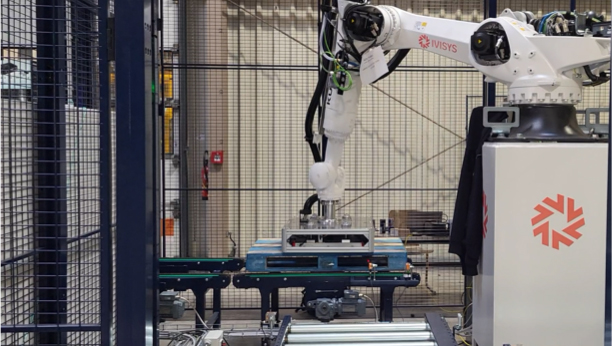Our PALLETAI in short
Our pallet inspection solution, the PALLETAI, is a smart hack for logistics success. The PALLETAI inspects the pallet to secure the pallet quality by detecting defects that not are beneficial for your production or logistics chain. The PALLETAI enables you to focus on uptime, production, efficiency, logistics, and employee safety. It helps you avoid space waste, load imbalance, stop in production, and material loss and can be used for both wooden and plastic pallets as well as being applied to nearly all pallet configurations.

The importance of high-quality pallets
Using pallets of the right quality is crucial when it comes to automatization with a high and stable level of productivity. With the PALLETAI you can make sure not to allow defective pallets to enter your retail, production line or warehouse and logistics center.
PALLETAI is adaptable to your existing production line, enables scalable production and assures high-speed inspection, rejection and sorting based on defect type such as protruding nails, cracks in boards & blocks, missing, broken or dislocated boards or blocks, blocked tunnels, logo detection and verification (including iPAL QR codes etc.), paper and plastic residue and sorting based on appearance.
As automation and automated processes increase, pallet quality plays a crucial role in securing the productivity of pallet conveyance, automated storage, retrieval systems or palletizing.
Simply put, with the PALLETAI, you can make more money by:
- Reduce claims from client due to inconsistent quality
- Reduce damaged goods
- Increase quality assurance
- Increase sorting activity productivity
- Reduce staff costs spent on pallet inspection
- Increase the safety of your employees and warehouse
PALLETAI advantages
- Artificial Intelligence functions as a human-like inspector, thoroughly examining the pallet
- AI finds cracks and holes but also segments pallet parts with great accuracy for measurement and control
- AI similarly is perfect for detecting mold or discoloration through pattern recognition
- PALLETAI runs no less than 26 Neural Networks
- AI is better at finding visual defects which up until now has required human interaction – contamination, fungi, etc.
- 2D cameras are combined to achieve maximum effect
Both color and black & white images acquired - Lasers and tailored illumination
- Filters on cameras guarantee that only what is in focus will be captured, creating a robust system to contend with changing environments (sun, factory light)
- Precise triggering and instant analysis to deliver results
PALLETAI inspection areas
Top side:
- Length and width
- Length and width individual board
- Material loss
- Protruding material
- Component alignment
- Cracks on boards
- Skewness and planarity
- Discoloration and foreign material
Side:
- Stamps
- Cracks
- Plastic wrap/threads
- Discoloration and foreign material
Bottom side:
- Analysis of tunnels
- Tunnel width and height
- No material in tunnels
- Perimeter blocks and stringers
- Material loss/missing component
- Rotation
- Cracks
- Broken and repaired
- Analysis of deck & cross boards
- Chips/wants/cracks
- Material Loss
- Missing components

Why settle for defective pallets?
No logistics process is the same, each one requires pallet quality that caters to the specific needs. However, we can all agree that the logistics challenges can be reduced with good pallet quality, which clearly improves the warehouse efficiency. With IVISYS PALLETAI you can tailor the acceptance and rejection criteria for both empty and loaded pallets, wooden and plastic pallets, making sure it addresses your specific needs. So, why should you settle for defective pallets when there is a solution with modern inventory techniques that can give you peace of mind and solve your logistics challenges?
Using pallets of the right quality is crucial when it comes to automatization. With the right pallet handling you can easily improve the warehouse flow and improve the logistics efficiency. With an automated pallet inspection system, you can make sure not to allow defective pallets to enter your automated material handling systems.
That’s where we come in, or i.e., the IVISYS PALLETAI which is a state-of-the-art pallet inspection solution helps you to manage your pallets regardless of type, brand or quality.
Real time data
The PALLETAI uses the NVIDIA Tesla GPUs, that are the engines of the modern HPC data center. They deliver a breakthrough performance with fewer servers. The result and reports of the data is based on faster insights and dramatically reduced costs due to decreased downtime by having the accurate information in time.
IVISYS pallet inspection solution, the PALLETAI, can give you information and to sense variations in small patterns. Our high-resolution images are fed to our deep neural networks, taking advantage of the latest Nvidia Data Center GPUs that deliver rapid computation and a huge amount of memory.
And it’s all happening IRL. When inspecting the pallets in the PALLETAI you will receive real time data, all based on your specific needs. The recipe you get will tell you if the pallet passed or failed, if it’s good to go or needs to take out of the production line or logistics flow.
- The PALLETAI facilitates real time data monitoring and remote supervision
- The interface adapts to different pallet types and is accessible remotely for super vision
- All data is transferred to the IVISYS Cloud ready for analysis
- PALLETAI delivers pre configured data with standard measurements commonly used for sorting, all based on your specific needs
- Tolerances can easily be adapted to your changed production and logistics needs
It’s all about uptime
Optimize efficiency and quality with PALLETAI
Secure your pallets
Make sure that the pallets entering operation are suitable to use, increasing uptime and efficiency.
Save money
Cut down on expenses related to manual sorting while simultaneously enhancing the pallet quality.
Smaller ecological footprint
Decrease the footprint impact of your end-to-end system compared to traditional mechanic and manual sorting systems.
Unlimited uptime
The PALLETAI allows running your sorting operation continuously 24/7 and it never becomes fatigued.
Increased capacity
The PALLETAI increases your sorting capacity up to fivefold compared to a human operator.
Collecting data
The PALLETAI keeps track of which suppliers that are delivering goods on pallets of lesser quality.
